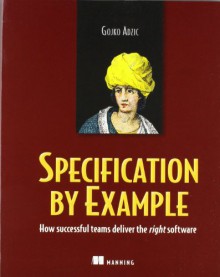SummarySpecification by Example is an emerging practice for creating software based on realistic examples, bridging the communication gap between business stakeholders and the dev teams building the software. In this book, author Gojko Adzic distills interviews with successful teams worldwide,...
show more
SummarySpecification by Example is an emerging practice for creating software based on realistic examples, bridging the communication gap between business stakeholders and the dev teams building the software. In this book, author Gojko Adzic distills interviews with successful teams worldwide, sharing how they specify, develop, and deliver software, without defects, in short iterative delivery cycles. About the TechnologySpecification by Example is a collaborative method for specifying requirements and tests. Seven patterns, fully explored in this book, are key to making the method effective. The method has four main benefits: it produces living, reliable documentation; it defines expectations clearly and makes validation efficient; it reduces rework; and, above all, it assures delivery teams and business stakeholders that the software that's built is right for its purpose. About the BookThis book distills from the experience of leading teams worldwide effective ways to specify, test, and deliver software in short, iterative delivery cycles. Case studies in this book range from small web startups to large financial institutions, working in many processes including XP, Scrum, and Kanban.This book is written for developers, testers, analysts, and business people working together to build great software. Purchase of the print book comes with an offer of a free PDF, ePub, and Kindle eBook from Manning. Also available is all code from the book. What's Inside Common process patterns How to avoid bad practices Fitting SBE in your process 50+ case studies For additional resources go to specificationbyexample.com.=============================================== Table of Contents Part 1 Getting started Key benefits Key process patterns Living documentation Initiating the changes Part 2 Key process patterns Deriving scope from goals Specifying collaboratively Illustrating using examples Refining the specification Automating validation without changing specifications Validating frequently Evolving a documentation system Part 3 Case studies uSwitch RainStor Iowa Student Loan Sabre Airline Solutions ePlan Services Songkick Concluding thoughts
show less

